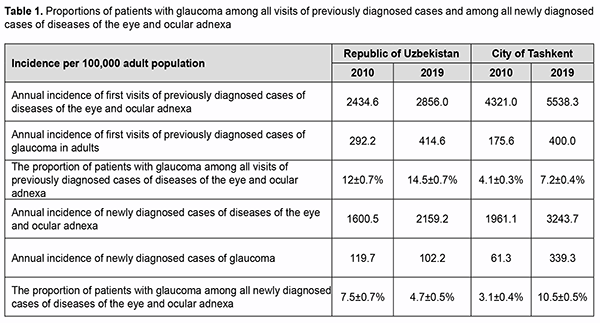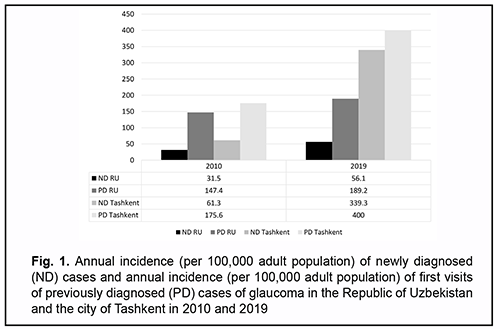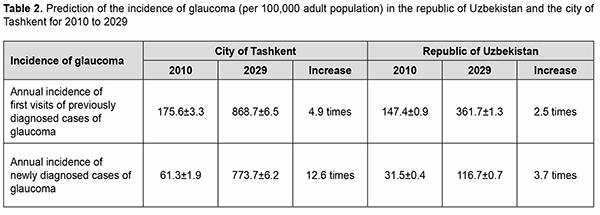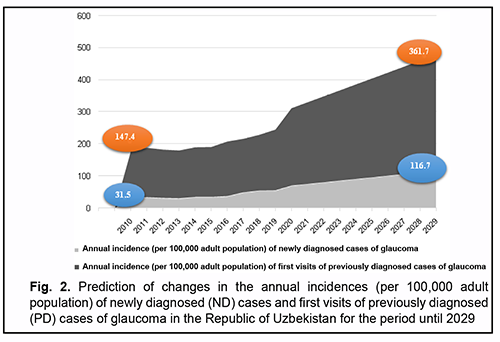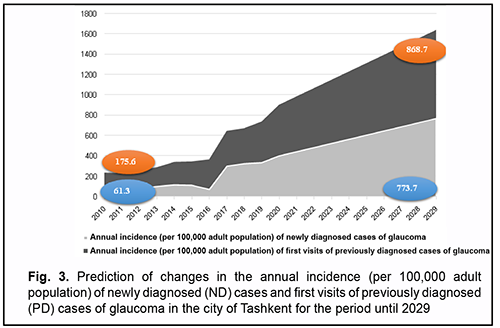J.ophthalmol.(Ukraine).2021;4:43-47.
|
http://doi.org/10.31288/oftalmolzh202144347 Received: 28 December 2020; Published on-line: 16 August 2021 Longitudinal changes in the incidence of glaucoma in Uzbekistan D. M. Tuychibayeva 1, Zh. A. Rizayev 2, N. K. Stozharova 1 1 Tashkent State Dentistry Institute; Tashkent (Uzbekistan) 2 Samarkand State Medical Institute;Tashkent (Uzbekistan) E-mail: dyly@mail.ru TO CITE THIS ARTICLE: Tuychibayeva DM, Rizayev ZhA, Stozharova NK. Longitudinal changes in the incidence of glaucoma in Uzbekistan. J.ophthalmol.(Ukraine). 2021;4:43-7. http://doi.org/10.31288/oftalmolzh202144347 Background: Glaucoma is not only one of the most common, but also one of the most severe chronic and progressive eye diseases. Therefore, the disease is a relevant problem in ophthalmology and a leading cause of reduced vision and irreversible blindness. Purpose: To assess the incidence of glaucoma in the republic and the city of Tashkent, and predict disease incidence for the subsequent decade. Material and Methods: The report of the Ministry of Health “On the numbers of diseases and registered patients residing in the primary service area of the medical facility» and national statistical collections (“Statistical materials on the activities of healthcare institutions of the Republic of Uzbekistan”) for 2010-2019 were studied to determine the incidence of glaucoma and the relevant characteristics in the republic. Results: These materials allowed us to obtain the data on annual incidences of newly diagnosed cases and annual incidences of first visits of previously diagnosed cases of glaucoma in adults (i.e., individuals older than age 19) in the regions of the country for 2010 to 2019 years. The prediction of the incidence of glaucoma in the republic of Uzbekistan and the city of Tashkent necessitates organizational and treatment-and-diagnostic measures for combating the disease, these measures being of a social and medical importance. Keywords: glaucoma, annual incidences of newly diagnosed cases and first visits of previously diagnosed cases, Uzbekistan, Tashkent
Introduction Glaucoma is not only one of the most common, but also one of the most severe chronic and progressive eye diseases. Therefore, the disease is a relevant problem in ophthalmology and a leading cause of reduced vision and irreversible blindness [1, 2, 3, 4, 5, 6]. Glaucoma is the leading cause of visual impairment and disability [7, 8, 9, 10, 11, 12]. Foreign studies have demonstrated an increase in the incidence of the disease among adults [1, 2, 3, 6, 7, 8]. It was predicted in 2006 that, globally, there would be 60.5 million people with glaucoma in 2010, increasing to 79.6 million by 2020, and over 8.4 million people would be bilaterally blind from primary glaucoma in 2010, rising to 11.1 million by 2020 [9]. Glaucoma is believed by Nesterov and others [6, 10] to be a multifactorial disease with a threshold effect and without clear etiology. In addition, early detection of glaucoma is challenging, and national incidence and disability due to glaucoma are regularly assessed in many countries [5]. Glaucoma screening is of crucial importance and allows early disease detection, which is beneficial for disease course and treatment outcomes [6, 7, 8]. There are scarce data on the incidence of glaucoma in the Republic of Uzbekistan for the recent decade, indicating a necessity for glaucoma screening in the country. Therefore, the pur-pose of this study was to assess the current incidence of glaucoma in the republic and the city of Tashkent, and predict disease incidence for the subsequent decade. Material and Methods The report of the Ministry of Health “On the numbers of diseases and registered patients residing in the primary service area of the medical facility» and national statistical collections (“Statistical materials on the activities of healthcare institutions of the Republic of Uzbekistan”) for 2010-2019 were studied to determine the incidence of glaucoma and the relevant characteristics in the republic. These materials allowed us to obtain the data on annual incidences of newly diagnosed cases and annual incidences of first visits of previously diagnosed cases of glauco-ma in adults (i.e., individuals older than age 19) in the regions of the country for 2010 to 2019 years. In addition, the retrospective analysis of the statistical reports from the ministry allowed predicting changes in the incidence of glaucoma in the adult population for the near and far future. A linear regression was used for prediction. Microsoft Excel 7.0 software was used for statistical analysis. Student t test was employed to assess difference between the groups. The level of significance p < 0.05 was assumed. Results Our analysis based on the report of the Ministry of Health “On the numbers of diseases and registered patients residing in the primary service area of the medical facility” and national statistical collections (“Statistical materials on the activities of healthcare institutions of the Republic of Uzbekistan”) for 2010-2019 found that, from 2010 through 2019, the annual incidence of newly diagnosed cases of glaucoma in adults increased 1.8 times, from 31.5 ± 0.4 to 56.1 ± 0.5 per 100,000 adult population (Р ≤ 0.05), for the country in total, and much more substantially, 5.5 times, from 61.3 ± 1.9 to 339.3 ± 4.4 per 100,000 adult population (Р ≤ 0.05), for the city of Tashkent. The annual incidence of first visits of previously diagnosed cases of glaucoma in adults also increased during this period. Thus, from 2010 through 2019, the annual incidence of first visits of previously diagnosed cases of glaucoma in adults increased 1.3 times, from 147.4 ± 0.9 to 189.2 ± 1.0 per 100,000 adult population (Р ≤ 0.05), for the country in total, and 2.3 times, from 175.6 ± 3.3 to 400.0 ± 4.7 per 100,000 adult population (Р ≤ 0.05), for the city of Tashkent. Among all patients with eye diseases, the proportion of patients with glaucoma in Uzbekistan and the city of Tashkent is within the same range as in other Asian countries. Thus, among all patients with eye diseases, the mean proportion of patients with glaucoma in Uzbekistan and the city of Tashkent for the decade was 13.2% and 5.6%, respectively (Table1). In addition, during 2010 through 2019, among all newly diagnosed cases of eye diseases de-tected annually, the proportion of patients with glaucoma in the city of Tashkent increased three times, from 3.1 ± 0.4% to 10.5 ± 0.5%, and in Uzbekistan decreased from 7.5 ± 0.7% to 4.5 ± 0.5%, and these changes were statisti-cally significant (p ≤ 0.05). However, among all newly diagnosed cases of the diseases of the eye and ocular adnexa detected annually, the proportion of patients with glaucoma in Uzbekistan increased from 12 ± 0.7% in 2010 to 14.5 ± 0.7% in 2019, and in the city of Tashkent increased from 4.1 ± 0.3% in 2010 to 7.2 ± 0.4% in 2019 (p ≤ 0.05). A linear regression equation was used to calculate the predicted changes in the annual incidence of newly diagnosed cases of glaucoma and in the annual incidence of first visits of previously diagnosed cases of glaucoma in adults in Uzbekistan and in the city of Tashkent for the period until 2029.
It is estimated that by 2029, the annual incidence of glaucoma in adults would increase several times, all other factors held constant (Table 2). Particularly, it is estimated that the annual incidence of newly diagnosed cases of glaucoma in adults in Uzbekistan will increase 3.7 times, from 31.5 ± 0.4 per 100,000 adult population in 2010, to 116.7 ± 0.7 per 100,000 adult population in 2029 (Fig. 2). In addition, the annual incidence of first visits of previ-ously diagnosed cases of glaucoma in adults in the country will increase 2.5 times, from 147.4 ± 0.9 per 100,000 adult population in 2010, to 361.7 ± 1.3 per 100,000 adult population in 2029 (p ≤ 0.05).
Moreover, the annual incidence of newly diagnosed cases of glaucoma and the annual incidence of first visits of previously diagnosed cases of glaucoma in adults in Tashkent will increase more substantially, 12.6 times (from 61.3 ± 1.9 to 773.7 ± 6.2) and 4.9 times (from 175.6 ± 3.3 to 868.7 ± 6.5), respectively, all other factors held con-stant (Fig. 3).
Discussion Among all patients with eye diseases, the proportion of patients with glaucoma in the world is about 12-14%. This proportion is, however, as large as 11-20% in the eastern countries like India, Yemen, China, Singapore and Syria [11-17]. Over the recent decades, in Uzbekistan and the city of Tashkent, as in many other countries, there has been a steady growth in the annual incidence of glaucoma in the adults older than 40 years. Our analysis demonstrated that, among all patients with eye diseases, the proportion of patients with glaucoma in Uzbekistan and the city of Tashkent is within the same range as in other Asian countries. Thus, in Uzbekistan and the city of Tashkent, among all patients with eye diseases, the mean proportion of patients with glaucoma for the decade was 13.2% and 5.6%, respectively, whereas the annual incidence of newly diagnosed cases of glaucoma in adults increased 1.8 times and 5.5 times, respectively (p ≤ 0.05). In addition, there was an increase in the annual incidence of first visits of previously diagnosed cases of glau-coma in adults. Thus, from 2010 through 2019, the annual incidence of first visits of previously diagnosed cases of glaucoma in adults increased 1.3 times for the country in total, and 2.3 times, for the city of Tashkent. The higher incidence of glaucoma in Tashkent compared to other regions of the country can be explained by not only better provision of eye care service, and, consequently, better detection of glaucoma process, but also by the age structure of the population, with the age group of 60 years and above representing more than 15.7% of the population for the city, compared to 10% for the total country [18]. And it is the senior age groups that constitute a major portion of patients with glaucoma [1, 2, 3, 4, 11]. It is estimated that, from 2010 through 2029, the annual incidence of newly diagnosed cases of glaucoma in adults and the annual incidence of first visits of previously diagnosed cases of glaucoma in adults in the country will increase 3.7 times and 2.5 times, respectively (p ≤ 0.05), whereas those in the city of Tashkent will increase 12.6 times and 4.9 times, respectively (p ≤ 0.05). It is likely that an increase in the incidence of glaucoma will be associated not only with an improvement in the quality and increase in the amount of eye care given, but also with an increase in the proportion of older people in the population of the republic. Thus, the proportion of people older than age 60 in the population of Uzbekistan is somewhat more than 10% currently, and will increase to 30-35% by 2030, with a current increase in life expectancy and low level of total mortality [18]. Given a high level of glaucoma-associated disability and increased risk of premature mortality due to glaucoma, the above increase in the incidence of glaucoma in the republic makes the management of the disease an important medical and social challenge for Uzbekistan, necessitating further studies, improvement in treatment quality, devel-opment of advanced methods of prevention and early detection and incorporation of these methods into clinical practice.
References 1.Avdeev RV, Alexandrov AS, Bakunina NA, Basinsky AS, Blum EA., Brezhnev AYu, et al. [Prediction of disease duration and age of patients with different stages of primary open-angle glaucoma]. Natsionalnyi zhurnal glaucoma. 2014; 13(2):60-69. Rus-sian. https://doi.org/10.25700/NJG.2019.01.07. 2.Egorov EA, Kuroedov AV. [Clinical and epidemiological characteristics of glaucoma in CIS and Georgia. Results of multicenter opened retrospective trial (part 1)]. Rossiiskii Meditsinskii zhurnal. Klinicheskaia Oftalmologiia. 2011; 12(3):97-100. Russian. 3.Egorov EA, Astakhov YuS, Erichev VP, editors. [National Guidelines for Glaucoma For Medical Practitioners]. 3rd ed., rev. and enlarged. Moscow: GEOTAR-Media; 2015. Russian. 4.Egorov EA, Astakhov YuS, Erichev VP, editors. [National Guidelines for Glaucoma For Medical Practitioners]. 4th ed., rev. and enlarged. Moscow: GEOTAR-Media; 2019. Russian. DOI: 10.33029/9704-5442-8-GLA-2020-1-384. 5.Neroev VV, Kiseleva OA, Bessmertny AM. [The main results of a multicenter study of the epidemiological features of primary open-angle glaucoma in the Russian Federation]. Rossiiskii oftal’mologicheskii zhurnal. 2013;6 (3):43–46. Russian. Available from: https://roj.igb.ru/jour/manager/files/archive//РОЖ_3_2013.pdf. 6.Libman YeS, Kaleyeva EV, Ryazanov DP. [Characteristics of visual disability in the Russian Federation]. Rossiiskaia oftal'mologi-ia. 2012; 5:24-26. Russian. Available from: https://eyepress.ru/article.aspx?8868 7.Babushkin AE, Orenburkina OI, Matyukhina EN, et al. [Analysis of the prevalence and incidence of and disability due to glaucoma in the Republic of Bashkortostan]. Vestnik Orenburgskogo gosudarstvennogo universiteta. 2011; 14: 45–48. Russian. https://doi.org/10.25198/1814-6457 8.Baranov VI, Brezhnev AYu, Tolmacheva EM. [Social and economical and epidemiological aspects of glaucoma in Kursk region]. In: [Eliminating Avoidable Blindness: A WHO World Initiative. Elimination of Childhood Blindness: Proceedings of the 6th Russian Interregional Symposium]. Moscow. 2012:46-48. Russian. 9.Quigley HA, Broman AT. The number of people with glaucoma worldwide in 2010 and 2020. Br J Ophthalmol. 2006 Mar; 90(3):262–7. 10.Nesterov AP. [Glaucoma]. Moscow:Medinformagenstvo; 2008. Russian. 11.Sharaf VM, Siplivyi VI. [Epidemiological features of the clinical course of glaucoma depending on social, economical, ethnic and geographical factors]. Natsionalnyi zhurnal glaucoma. 2014;13(1):68-76. Russian. Available from: https://www.glaucomajournal.ru/jour/article/view/10/11 12.Rosman M, Zheng Y, Lamoureux E, et al. Review of key findings from the Singapore Malay Eye Study (SiMES-1). Singapore Medical Journal. – 2012; 53(2):82-7. 13.Al-Bahlal A, Khandekar R, Al Rubaie K, et al. Changing epidemiology of neovascular glaucoma from 2002 to 2012 at King Khaled Eye Specialist Hospital, Saudi Arabia. Indian J Ophthalmol. 2017 Oct;65(10):969-973. doi: 10.4103/ijo.IJO_33_17. 14.Islam FM, Chakrabarti R, Islam SZ, et al. Factors associated with awareness, attitudes and practices regarding common eye diseases in the general population in a rural district in Bangladesh: The Bangladesh Population-based Diabetes and Eye Study (BPDES) PLOS One. 2015;10:e0133043. 15.Katibeh M, Ziaei H, Panah E, et al. Knowledge and awareness of age related eye diseases: a population-based survey. J Ophthalmic Vis Res. 2014 Apr; 9(2): 223–31. 16.Ryskulova A, Turczyn K, Makuc DM, et al. Self-reported age-related eye diseases and visual impairment in the United States: results of the 2002 National Health Interview Study. Am J Pub Health. 2008;98:454–61. 17.Rizayev JA, Tuychibayeva DM. Prediction of glaucoma frequency and prevalence in Uzbekistan. Journal of Biomedicine and Practice. 2020; 6(5): 180-6. http://doi.org/10.26739/2181-9300-2020-6-28. 18.Akhmedov D, Kucera T. Uzbekistan Population Forecast 2018-50. UNFPA in Uzbekistan:Prague-Tashkent; 2019. Conflict of Interest Statement: No conflict of interest to declare.
|

